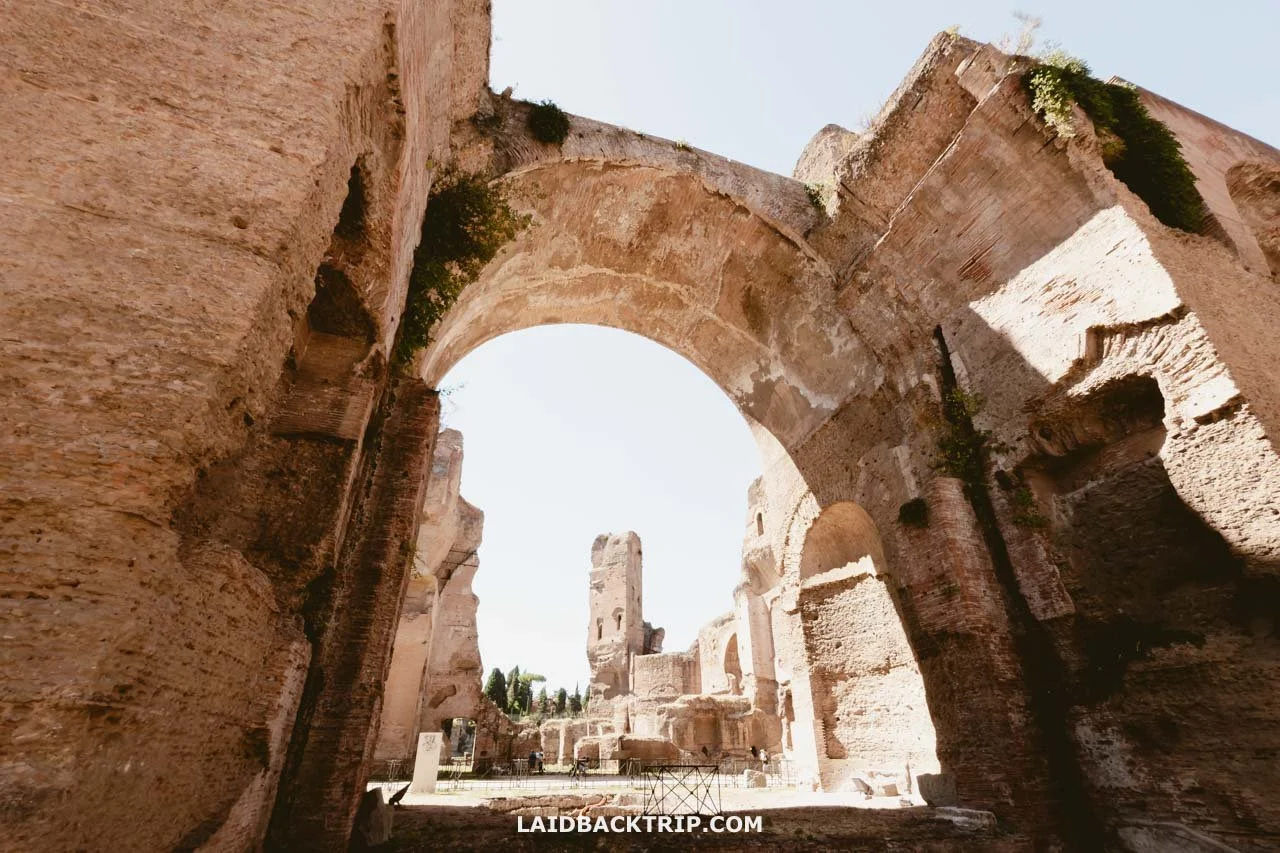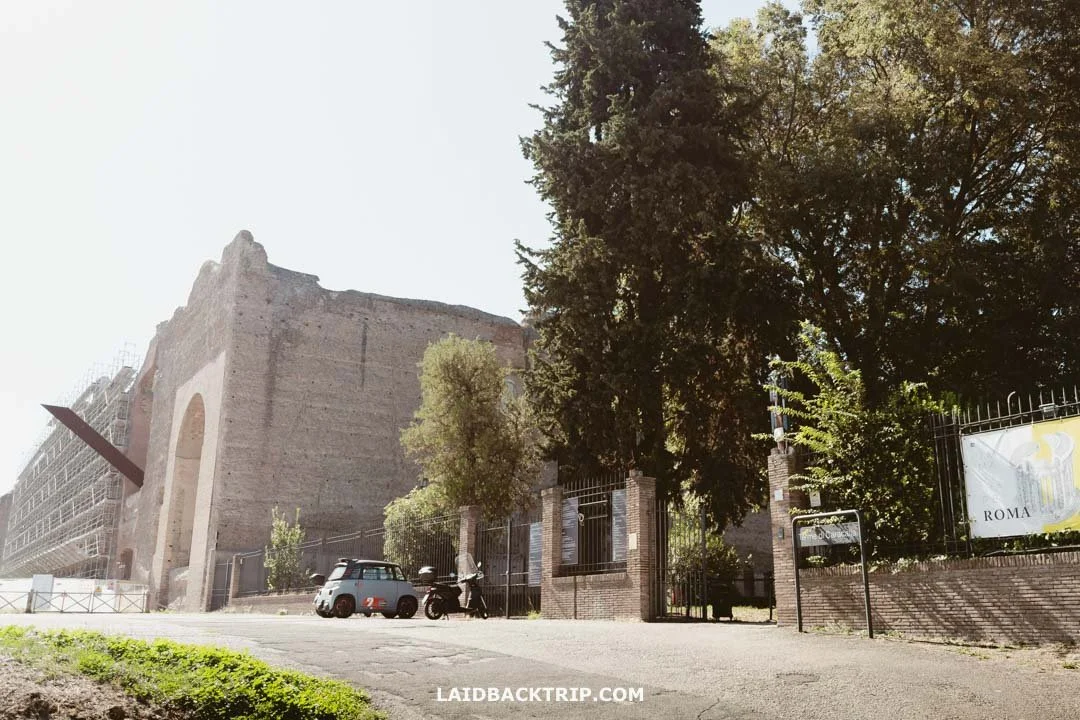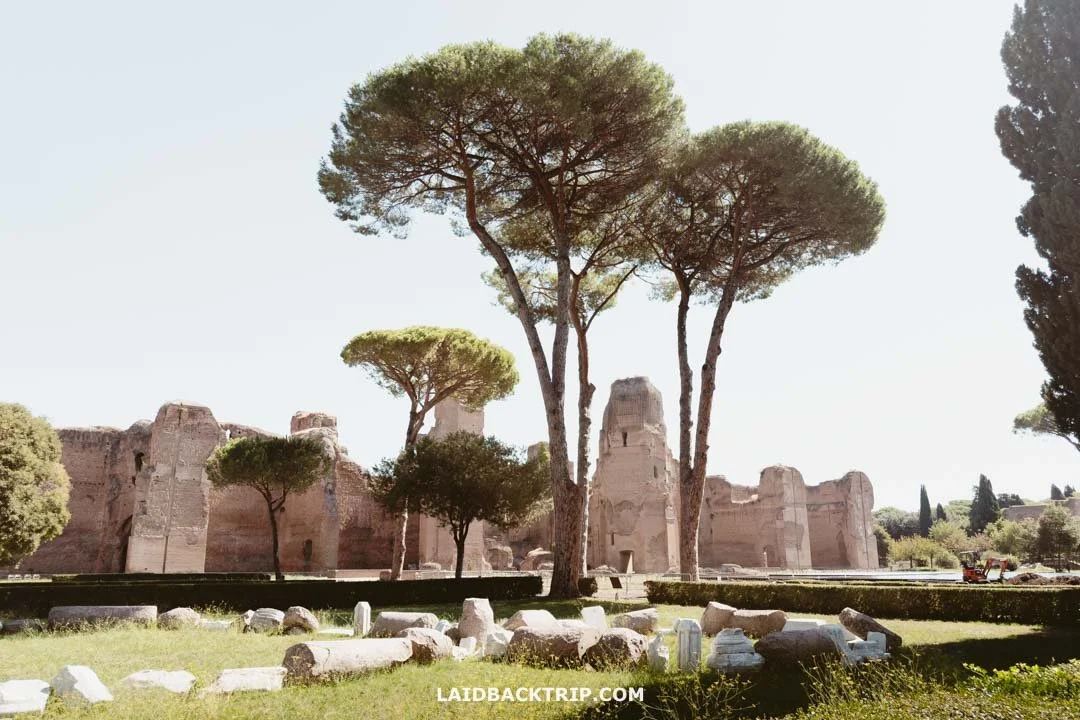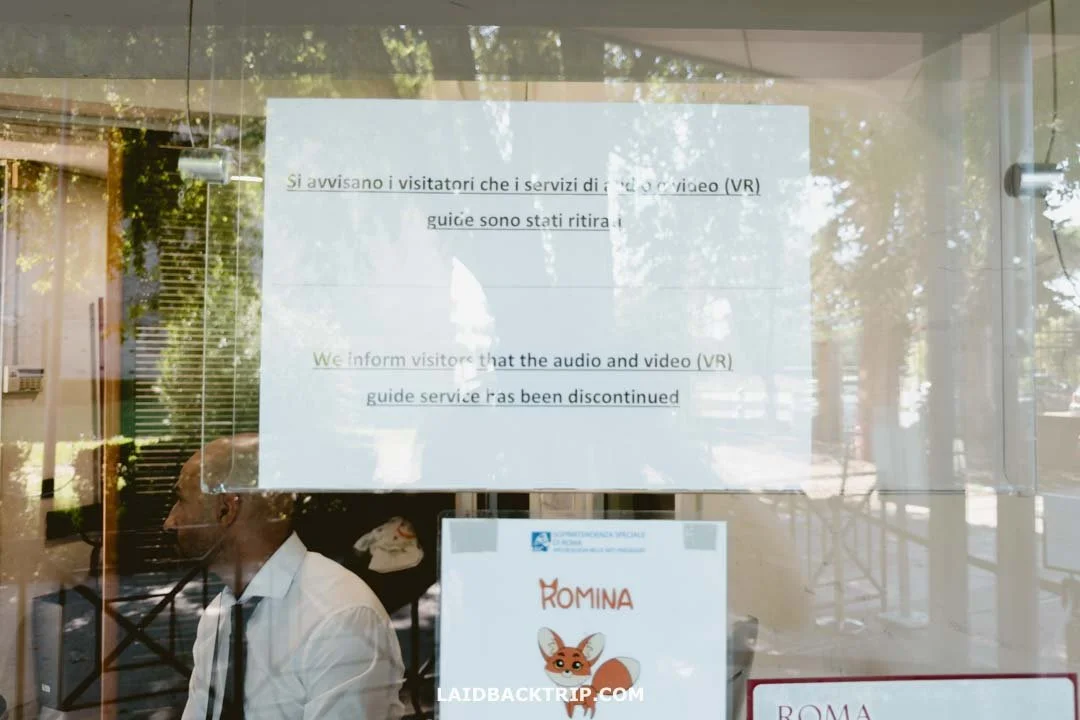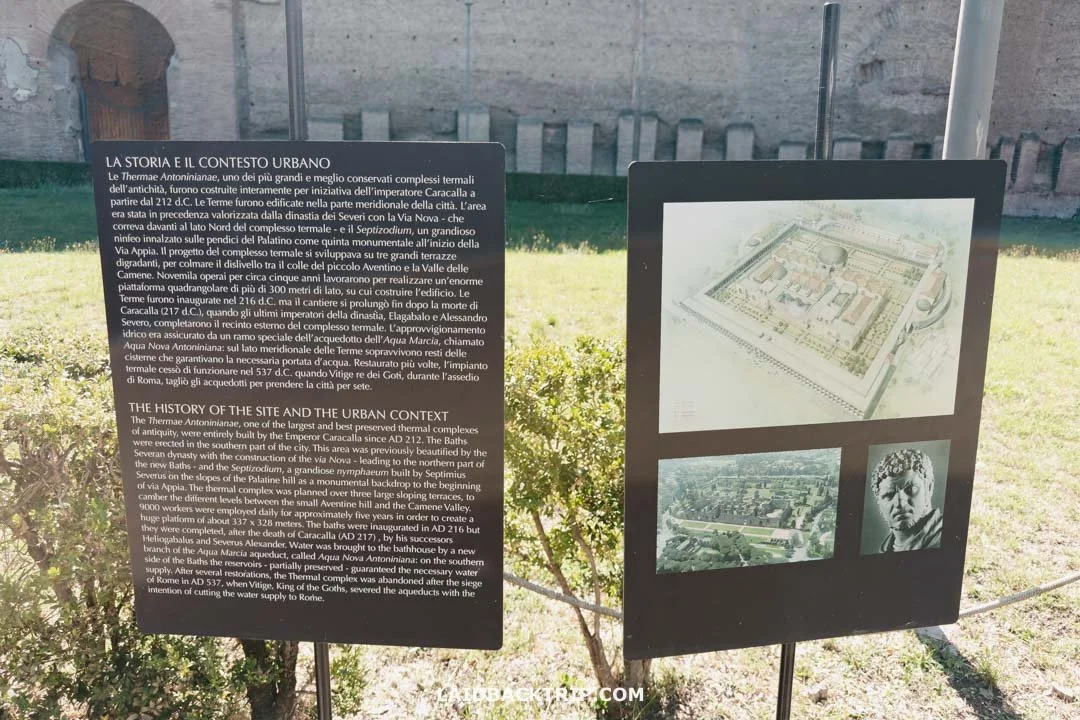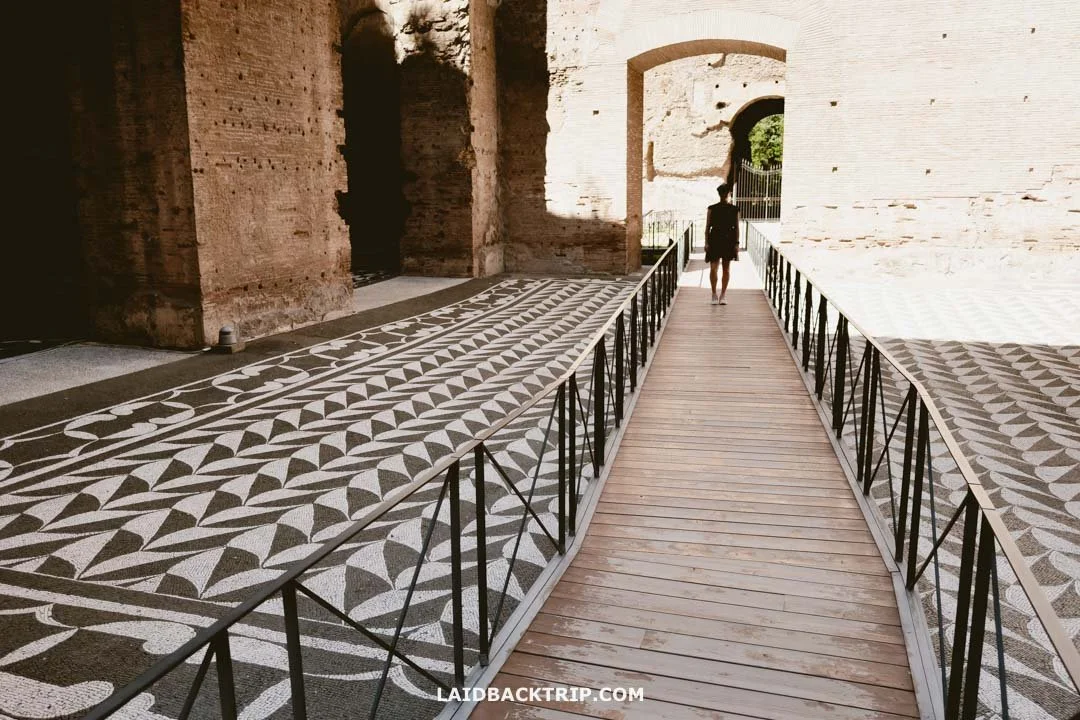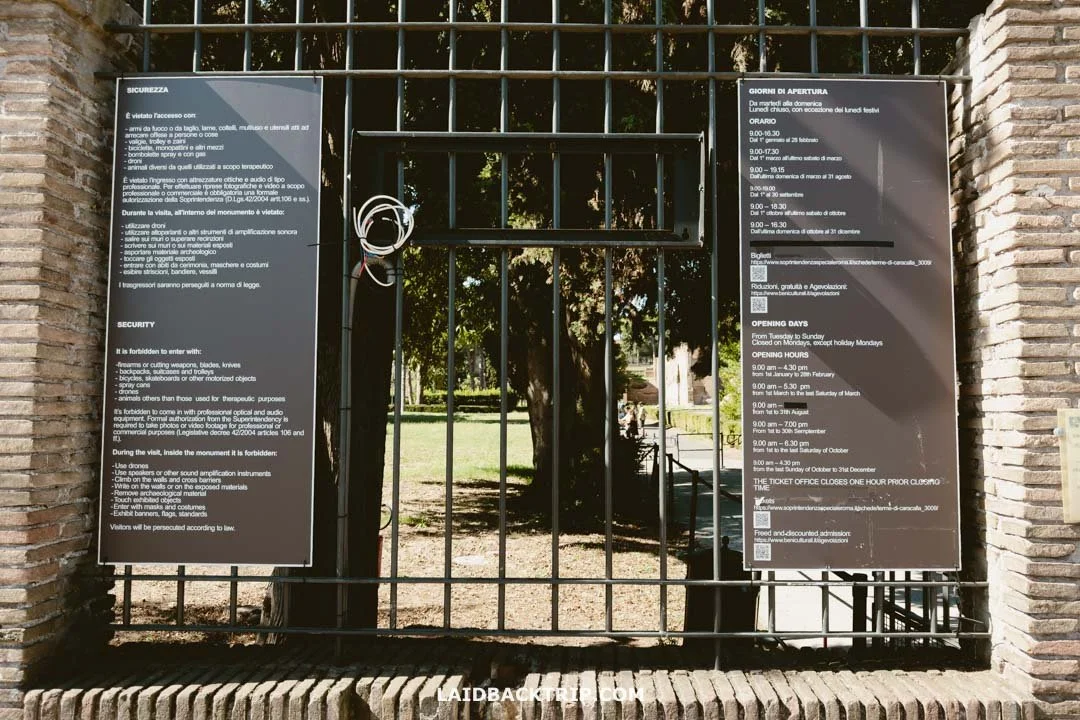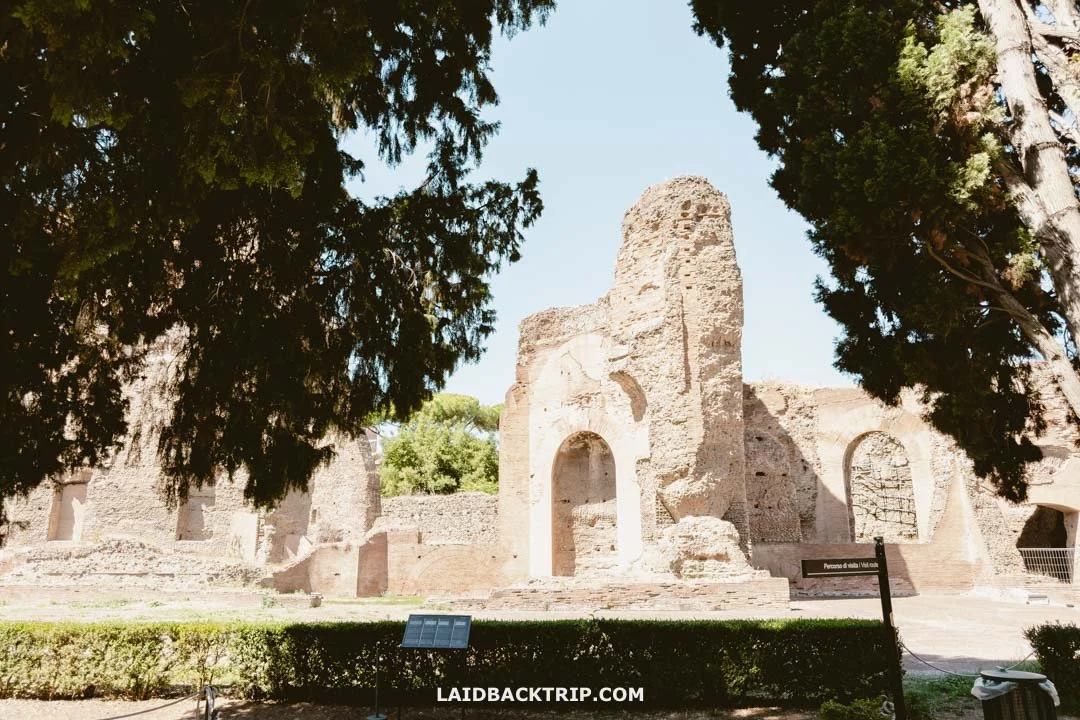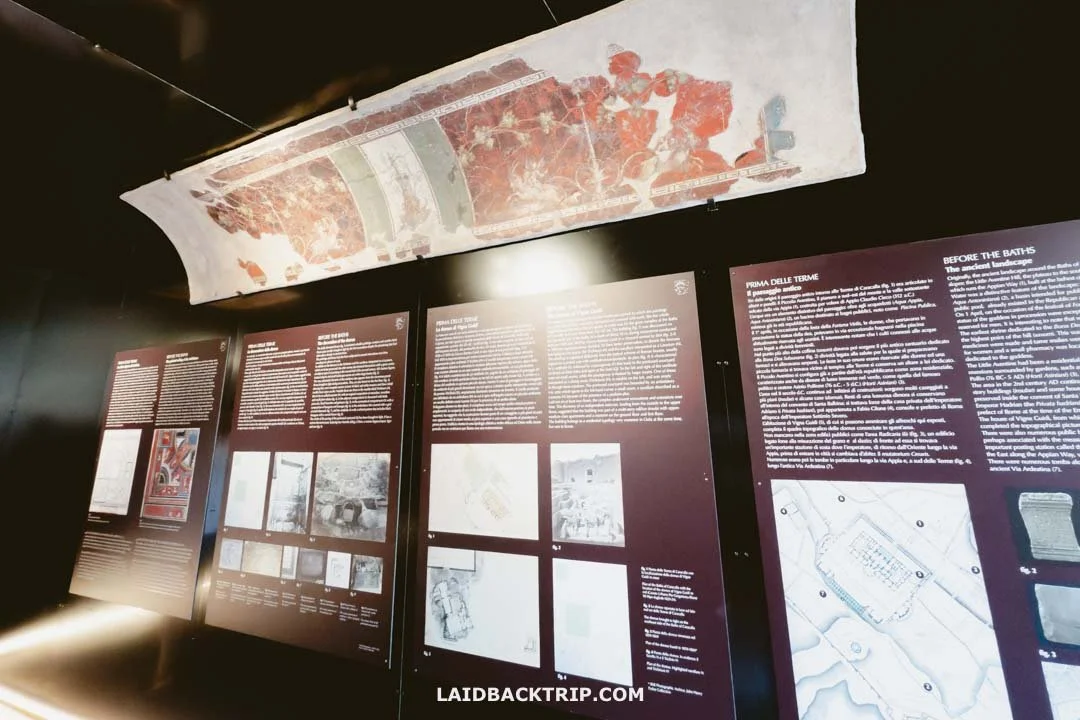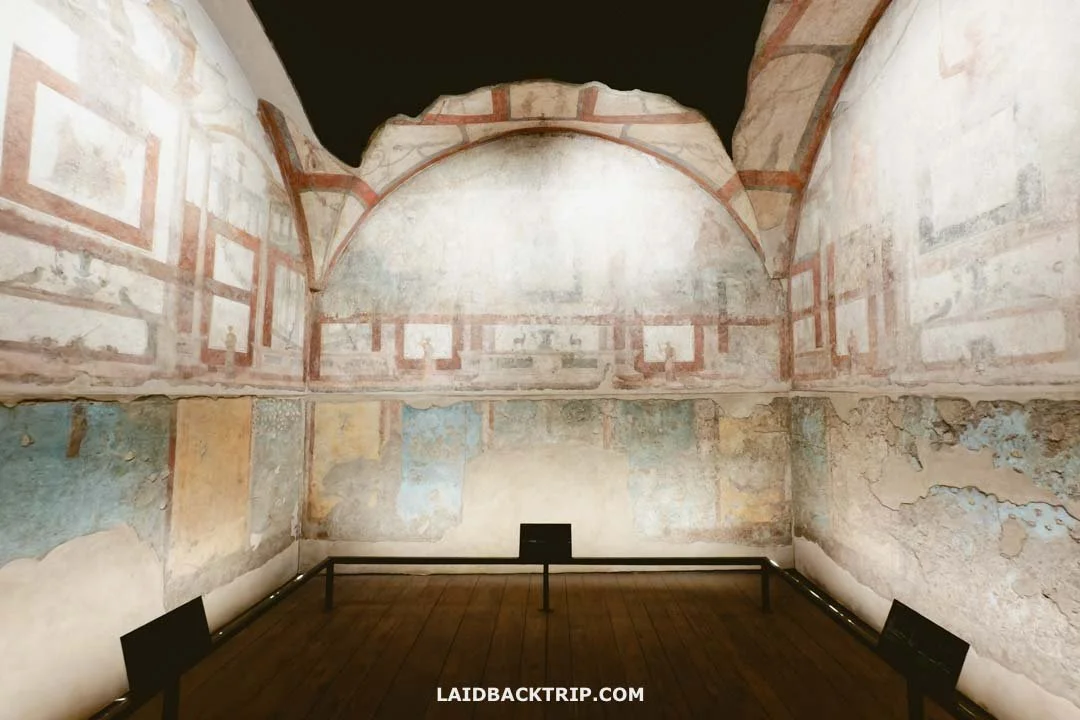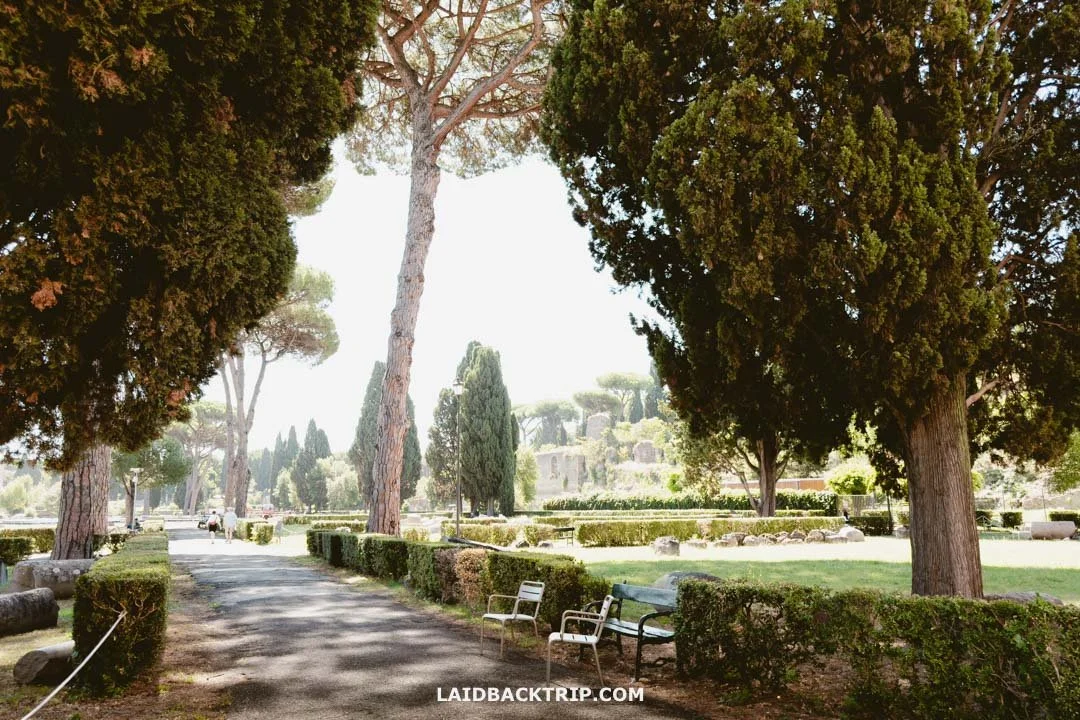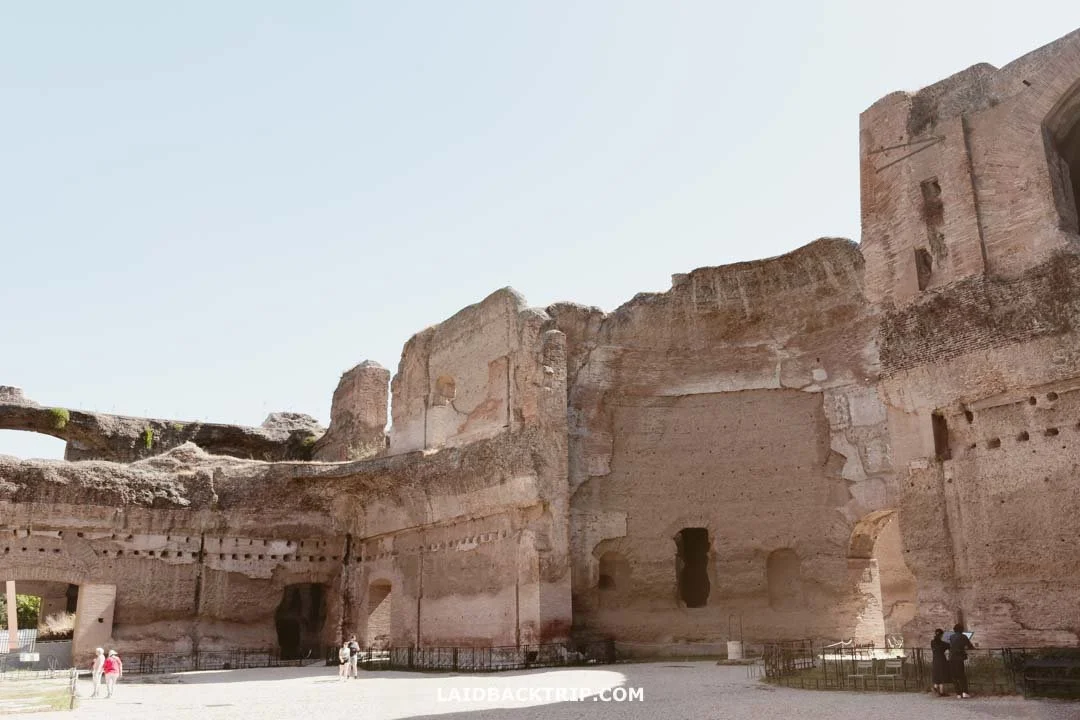How to Visit the Baths of Caracalla
The Baths of Caracalla were one of the biggest bath complexes ever built in Rome.
Here's a guide showing how Lucie and I explored the Baths of Caracalla.
Honestly, the Baths of Caracalla were one of the spots I was most excited to visit on our first trip to Rome with Lucie. I couldn't really explain why I felt like that, but I just did.
Maybe it was just because we love exploring Roman, or maybe it was because I figured that since they're a bit farther from the historic center, there would be fewer crowds. Or maybe it was that photo of the ruins reflected in a pool out front. Who knows.
Obviously, we had to check out the classic top attractions like the Colosseum and Pantheon first, which actually took us more time than we expected. But since we had eight days for the whole city, I knew we'd have enough time to see these baths too, so I wasn't worried about missing them. And quite honestly, there was plenty to be excited about.
Construction of the Baths of Caracalla started around 206 CE under Emperor Septimius Severus and was mostly finished and opened by his son, Emperor Caracalla, in 216 CE. The entire complex, including the outer perimeter, was completed around 235 CE. When it was done, the Baths of Caracalla were among the most impressive baths ever built in Rome. They could hold 8,000 people a day, and up to 1,600 at once.
But the Baths of Caracalla were way more than just baths. It was a great place to walk around and exercise, but it was also a hangout spot for all kinds of social activities. They even had libraries and a small stadium, and the whole complex showed off the emperor's wealth and power.
The Baths of Caracalla were one of the biggest bath complexes ever built in Rome.
Getting to Baths of Caracalla
The Baths of Caracalla were a bit farther from Rome's tourist center, but they were still within walking distance for us (we were staying at Hotel Navona). During the second half of our stay, we moved closer to Termini Station, so the Baths were about 2.5 kilometers from the Leonardo Boutique Hotel where we stayed. Earlier, we were in the Centro Historico near Piazza Navona, which would have been a 3-kilometer walk, just to give you an idea.
We picked walking to the Baths of Caracalla for two reasons. First, we really enjoy seeing a city on foot, and second, there were four places along the way we wanted to check out. Coincidentally, two were baths, and the other two were big churches.
Even though the Baths of Caracalla were a little out of the center, we decided to walk there.
The Baths of Titus and the Baths of Trajan were right beside each other in Parco del Colle Oppio, just by the Colosseum. The Papal Basilica of Saint Mary Major came before, and the Basilica of San Giovanni in Laterano was after.
All in all, it was a pretty nice walk, even if Parco del Colle Oppio had some shady individuals hanging around, even early in the day. Both churches were impressive, while the baths were just ruins that we stopped at briefly.
There are a few ways to reach the Baths of Caracalla. We went on foot, but you can also take bus 118, which stops right in front of the baths and departs from places like Piazza Venezia (the one with the Monument to Victor Emmanuel II), the Colosseum, Circus Maximus, or the Roman Forum.
For example, we later hopped on this bus from Via Appia Antica back to the center of Rome (that time, we got off at the Capitoline Museums). There's also a metro stop at Circus Maximus, about 600 meters from the Baths of Caracalla entrance (that's the closest one).
With a view like this, it's easy to see why we stayed longer than planned.
Travel Insurance
We never leave home without travel insurance that was designed to cover our expenses if something goes wrong during the trip. Travel insurance protects against theft, flight delays, injury, illness, cancellations, and much more. Travel smarter and safer!
World Nomads provides travel insurance for travelers to cover their trip essentials, including sports and adventure activities.
SafetyWing is affordable travel insurance for backpackers, long-term travelers, and digital nomads.
Tickets to the Baths of Caracalla
The night before our visit, I checked to see where we could actually get tickets for the Baths of Caracalla, but it didn't look like there was any official website selling them. So, we figured we'd just buy them at the entrance since it seemed like there wasn't really another option.
We'd already been to a handful of places, like Castel Sant'Angelo and Trajan's Market, where we just showed up without tickets and had no trouble getting in, so we figured this would be the same. And it was.
Sadly, the Baths of Caracalla don't offer audio guides anymore.
There were no lines at all, so we got our tickets super fast. The entry fee for the Baths of Caracalla was just €8, which seemed like a great deal for everything you could see there.
One thing we noticed was a small paper sign at the ticket booth saying they don't rent out audio guides or VR headsets anymore. It was a bit of a shame as VR might have been interesting here (unlike at the Stadium of Domitian, where we didn't really feel like it added anything).
Since that wasn't offered, we just had to use our imagination. Thankfully, there was a really nice info board with a drawing of how the Baths of Caracalla used to look. We also checked out a couple of YouTube videos with digital reconstructions later, and those were really awesome too.
This is what the Baths of Caracalla used to look like.
What's There to See in Baths of Caracalla
I bring this up because, without those reconstructions, it would have been much trickier to picture how amazing the Baths of Caracalla must have looked. Don't get me wrong. Even with what's left, it was obvious these were way more than just a few small baths. But the images just made it even clearer.
At the Baths of Caracalla, the natatio was a huge, Olympic-sized outdoor pool.
Looking at what's still standing, we could really tell that the Baths of Caracalla went through 1,500 years of neglect after closing in 537 CE, when the Ostrogoth King Vitiges destroyed the aqueducts during his siege of Rome.
Because of all that, the most preserved thing we saw was the huge brick walls of the central bath building, along with some arches and the whole layout of the pools and rooms inside. Standing right next to those walls really gave us a sense of just how massive this place used to be.
Lucie posed inside the Baths of Caracalla to give a sense of how massive the main building used to be.
My photos don't really do it justice, but the Baths of Caracalla were massive. These huge remains show just how enormous the original structure was, since it could hold more than 1,600 people at once.
When I got home, it was almost hilarious to compare my local swimming pool to this giant in my head. To be fair, the primary purpose of the Baths of Caracalla was hygiene. Unlike modern-day spa experiences, these baths served as a practical, everyday cleaning routine rather than a luxury or a sport.
While the main structure remains, most of the decorations were stripped away over the centuries. A lot of the famous art found in the ruins is now on display somewhere else, like the Farnese Bull and Farnese Hercules. Both beautiful sculptures are housed in the National Archaeological Museum in Naples, not Rome, unfortunately.
The mosaic floors were definitely one of the highlights of the visit.
Mosaics of Baths of Caracalla
Back in the day, the Baths of Caracalla were beautifully decorated with statues, columns, bronze pieces, and frescoes. After 1,500 years, though, the main thing that survived here was the incredible floor mosaics.
The Baths of Caracalla had some really gorgeous mosaics.
The most stunning ones were the colorful mosaics showing Roman athletes like wrestlers and boxers. Unfortunately, the best-preserved ones were taken from the Baths of Caracalla and are now in the Vatican Museums, so at least we got to see them there a few days earlier.
At the site, we could spot fragments of black and white mosaics showing figures, along with floor mosaics displaying classic Roman geometric patterns, and a few of those were colored.
Opening Hours of Baths of Caracalla
We visited the Baths of Caracalla in early September, which is basically still the summer season, and the site was open from 9 AM to 7 PM from Tuesday to Sunday. The hours change with the seasons, so the closing time drops to 6:30 PM, 5:30 PM, and then 4:30 PM in winter. Then, starting in March, they bump it back up again. Just a heads up. The baths are closed on Mondays.
The Baths of Caracalla are open every day except Mondays.
No Crowds at Baths of Caracalla
I had a feeling the Baths of Caracalla would be less crowded than the other big Roman ruins, but I definitely didn't expect them to be this quiet. Sure, the site is pretty big, but it's not as sprawling as the Roman Forum or Hadrian's Villa, so it's not like tourists can just disappear into a huge complex.
Even though we started the day pretty early, we stopped at two churches and checked out the other baths, so we didn't get to the site until after 10:30 AM. That meant we couldn't use our usual strategy of arriving early to beat the crowds. But honestly, we didn't need to.
Lucie soaking in the calm atmosphere at the Baths of Caracalla around midday.
Even from the street, the whole Baths of Caracalla complex looked calm, which we took as a good sign. There was no line for tickets, and when we walked in, there were only a few other tourists around. The best part was that it stayed that peaceful for our entire visit.
It's not like we had the place to ourselves, but for a site this size, it was way quieter than we expected. I think the biggest difference was the lack of those big tour groups we saw at the Colosseum or the St. Peter's Basilica. Maybe we just got lucky, but I'd guess the Baths aren't on the itinerary for most visitors who only spend a day or two in Rome, like those tours usually do.
We Explored the Baths of Caracalla Without a Tour
Since I brought up tours, I'll share a bit more about how we did our visit. Like usual, we went on our own. The whole place, with the main bathhouse and the surrounding park, was super easy to get around, so we just explored at our own pace.
We walked around the bathhouse by sticking to the main path. There wasn't much space to wander off, so it kind of felt like a one-way route, but we could always double back if we felt like it.
Green signs showed the suggested path for visitors.
The only thing we really wanted was more info panels explaining what we were seeing and how the baths worked. I have to admit, I felt like this info was a little thin.
For us, this wasn't our first time seeing Roman baths. We'd already checked them out in places like Masada National Park or Jerash, so we had a pretty good idea of how they worked and what to look for. But if this had been our first Roman baths, I think we would've left wanting to know more about it.
Sure, visiting the Baths of Caracalla with a guide would help, but like we said, it's not really essential if you've already seen some Roman baths before. If words like hypocaust or tepidarium sound familiar, you'll have no problem exploring on your own.
The Domus of Vigna Guidi
I mentioned earlier that we saw two other baths that morning. But at the time of our visit, both the Baths of Titus and the Baths of Trajan were just ruins fenced off from visitors. That might change someday, though, since Rome is always full of stories like this.
I saw it happen at Domus Tiberiana, for example, which was beautifully restored and finally opened after 50 years. I'm bringing this up because we found a similar story right here at the Baths of Caracalla.
The Domus of Vigna Guidi stood here before the bathhouse was built.
In the southeast corner of the bathhouse, we found a small 'museum' that had opened after 30 years of excavations. Inside, we realized it held two beautifully decorated rooms from a house that had once stood on this site before the baths were built. The house itself was discovered a bit farther away, and what really amazed us was that it was found 10 meters below ground!
Inside, we found plenty of info about the discovery, plus the beautiful paintings that once decorated this multi-storey 2nd-century CE mansion. In several ways, it brought to mind the Houses of Augustus and Livia on the Palatine Hill, which were also packed with Roman wall art.
We had no idea we would see these beautiful Roman paintings here.
Mirror Pool
We were only a little disappointed that the small pool, which, on calm days, reflects the Baths of Caracalla, was roped off with some maintenance going on. But honestly, it didn't matter much. What was neat was that this pool was only opened recently, so it brought water back to the baths for the first time in 1,500 years.
A big part of the park was closed, including the pool, sadly.
How Much to Spend at Baths of Caracalla
We honestly had no clue how much time to set aside for the Baths of Caracalla, so we decided to just come and spend as much time as we wanted. That turned out to be a great call because we ended up spending nearly three hours exploring the complex, which was way more than we expected.
The baths had gardens with exercise areas, plus extra facilities such as libraries and shops.
To be fair, we spent quite a bit of time relaxing in the shade of the stone pines, taking in the ruins, watching parakeets, and just soaking up the atmosphere. Since we were there during lunchtime, we brought snacks, too. I'd say we stayed a lot longer than most people, so a visit of 90 minutes to two hours is probably more realistic if you skip the breaks.
By the way, the whole complex felt pretty open, so we stuck to the shade whenever we could. We definitely weren't the only ones doing this, since the sun was still pretty intense and it was over 30 degrees Celsius. On top of that, we wore caps and made sure to bring some good sunscreen with us.
Water Fountains at Baths of Caracalla
Since we visited the baths around noon on a hot summer day, I knew we'd need plenty of water. Based on our past trips, we didn't bring too much with us, hoping we'd find some water fountains like at other sites in Rome. Our guess was right, as it was easy to get drinking water at the Baths of Caracalla.
After heading straight in from the entrance, we found a water fountain just past the main bathhouse, over by the park area. We came back here a few times to refill our bottles since it was right by the restrooms and super convenient.
Should You Visit the Baths of Caracalla?
Of all the similar sites we visited, the Baths of Caracalla gave us the best taste of what Roman baths were really like. Since we had some extra time and even a little curiosity about this part of Rome's history, we thought they were totally worth seeing.
For us, the Baths of Caracalla were on a whole different level when it came to the overall visitor experience, especially compared to the Baths of Titus and Baths of Trajan we checked out earlier that morning.
Even after 1,500 years, the Baths of Caracalla are still incredible.
The only other spot that offered something similar was the Baths of Diocletian at Piazza della Repubblica, right by Termini Station. That site has changed a ton, though, and now has a church, a cloister, and a big museum. It was definitely worth seeing, but the 'baths' experience felt a bit watered down since they turned much of it into a church.
Between the two, we'd probably pick the Baths of Diocletian over the Baths of Caracalla only if we were short on time, since they're right next to Termini, or if we were interested in the religious aspect. But in the end, I'm really glad we visited both, as each offered a fantastic experience in its own way.
Travel Resources
Here you can find links to all the travel resources we use and which you might find helpful when planning your next holiday.
Accommodation: When looking for accommodation, we usually search hotels via Booking.com or Hostelworld.
Tours: Although we love to travel independently, some places are better to visit with a guided tour.
We prefer GetYourGuide for its easy-to-use interface and solid reputation. Another great alternative is Viator.
Rental Cars: When going on a road trip, we always use Rentalcars.com, a reliable site for booking a rental car in advance.
Flight Tickets: When looking for flight tickets, you can search Skyscanner to find the best price.
Travel Insurance: World Nomads and SafetyWing cover against risks of travel.
